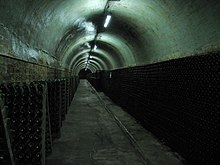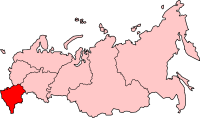Russian wine

Russian wine refers to wine made in Russia, at times also including the disputed region of Crimea.[1] The vast majority of Russia's territory is unsuitable for grape growing, with most of the production concentrated in parts of Krasnodar and Rostov regions, as well as Crimea.[2]
The Russian market is characterized by the presence of many low-cost products, with a significant part of local wines having a retail price of less than 100 rubles ($1.71).[3] Attempts to shift away from the low-quality reputation of Soviet wines has been moderately successful, though 80% of wines sold in Russia in 2013 were made from grape concentrates.[2]
In 2014 Russia was ranked 11th worldwide by the area of vineyards under cultivation.[3] The Russian wine industry is promoted by local authorities as a healthier alternative to spirits, which have a higher alcohol content.[4]
History

Wild
The founder of modern commercial wine-making in Russia was Prince
After the
Semi-sweet and sweet wines account for 80% of the Russian market, a share exceeding 90% in the economy segment.[7] Since 2006, Russian wineries have adopted European techniques and standards. The Abrau-Durso winery is considered the flagship of the new wine industry.[7]
In 2018 and 2019 several Russian wines were rated by Robert Parker of The Wine Advocate and scored between 80 and 97 points.[citation needed]
In 2020 Fanagoria Blanc de Blancs Brut, a 2017 wine from the Fanagoria Estate Winery in Fanagoria on the Taman Peninsula, was awarded a gold medal at the "Chardonnay du Monde" ("Chardonnay of the World") international tasting competition.[8]
Geography and climate

The climate of the
The area of
Wine and grapes

Russia produces wine of several different styles including still,
Russia currently has the following
A Russian wine guide published in 2012 lists 55 wines from 13 wineries, including names such as
See also
References
- ISBN 978-0-19-870538-3. Archivedfrom the original on 2017-04-04.
- ^ a b c Puzyrev, Denis (2 May 2013). "Coming soon: A great Russian wine". Russia Beyond The Headlines. Archived from the original on 24 July 2017. Retrieved 4 April 2017.
- ^ a b "Russia Announces Minimum Set Prices for Wine" (PDF). USDA Foreign Agricultural Service. Archived (PDF) from the original on 5 April 2017. Retrieved 4 April 2017.
- ^ a b "Wine in Russia". Euromonitor. Archived from the original on 4 April 2017. Retrieved 4 April 2017.
- ^ ISBN 0-19-860990-6.
- ^ "Home - Russian Wine Country". Russian Wine Country. Archived from the original on 17 December 2014. Retrieved 17 December 2014.
- ^ a b c Denis Puzyrev, special to RBTH (13 May 2014). "Raise a glass to Russia's world-class wines". Telegraph.co.uk. Archived from the original on 17 December 2014. Retrieved 17 December 2014.
- ^ "Results 2020 - RUSSIE". Retrieved 30 July 2020.
- ^ ISBN 0-19-860990-6.
- ^ "Golubok". wein.plus. Retrieved 2023-07-10.
- ^ "Сибирьковый" (in Russian). Retrieved 17 December 2014.
- ^ "Цимлянский черный" (in Russian). Retrieved 17 December 2014.
- ^ "Плечистик". Retrieved 17 December 2014.
- ^ "Нарма". Retrieved 17 December 2014.
- ^ "Гюляби дагестанский". Retrieved 17 December 2014.
External links
- Russia wines Archived 2013-06-14 at the Wayback Machine
- Russian wine industry today[permanent dead link]
